
The Berlin U-Bahn is a rapid transit system in Berlin, the capital and largest city of Germany, and a major part of the city's public transport system. Together with the S-Bahn, a network of suburban train lines, and a tram network that operates mostly in the eastern parts of the city, it serves as the main means of transport in the capital.
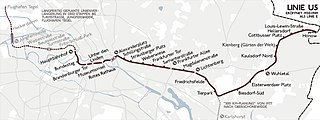
U5 is a line on the Berlin U-Bahn. It runs from Hauptbahnhof in Mitte eastwards through Alexanderplatz, Friedrichshain, Lichtenberg and Friedrichsfelde, surfaces in Biesdorf-Süd to pass Kaulsdorf and Hellersdorf above ground and finally reaches city limits at Hönow.

U6 is a Berlin U-Bahn line, 19.9 km (12.4 mi) long line with 29 stations. It runs in a north-south direction from the Berlin locality of Tegel in the north via Friedrichstraße to Mariendorf, a locality in the southern part of the city. It is a so-called large profile ("Großprofil") line.
The U7 is a rail line on the Berlin U-Bahn. It runs completely underground for a length of 31.8 kilometres (19.8 mi) through 40 stations and connects Spandau, via Neukölln, to Gropiusstadt and Rudow. The line was originally the south-eastern branch of the Nord-Süd-Bahn (U6) that ran between the branching point at Belle-Alliance-Straße (Mehringdamm) and Grenzallee; however, in the 1960s, this stretch was separated from the rest of the line and extended at each end to form a new line. As of 2007, the U7 is Berlin's longest underground line, both in terms of absolute length and total travel time, and one of the longest (entire) subterranean lines in Europe.

Jakob-Kaiser-Platz is a metro station on the Berlin U-Bahn line U7, located in the Charlottenburg-Nord district. It was opened on 1 October 1980 with the line's extension from Richard-Wagner-Platz to Rohrdamm. The eponymous traffic circle located above the station is named after politician and Resistance fighter Jakob Kaiser (1888–1961). The next station going eastbound is Jungfernheide
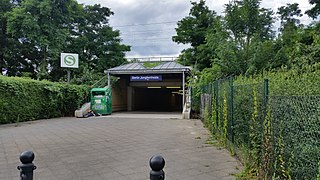
Berlin Jungfernheide is a railway station located at Charlottenburg-Nord, in the Charlottenburg-Wilmersdorf district of Berlin, served by the S-Bahn lines and , the U-Bahn line and Regional-Express trains of the Deutsche Bahn. Its name literally translates into "maidens' heathland"; it was named after the Jungfernheide, a former large forest in the proximity of this station.
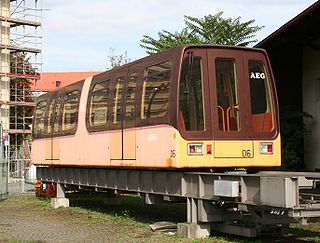
The M-Bahn or Magnetbahn was an elevated Maglev train line operating in Berlin, Germany, experimentally from 1984 and in passenger operation from 1989 to 1991. The line was 1.6 kilometres (1 mi) in length, and featured three stations, two of which were newly constructed. Presumed to be the future of rail transit in Berlin, the line was built to fill a gap in the West Berlin public transport network created by the construction of the Berlin Wall. It was rendered redundant by the reunification of Berlin and was closed to enable reconstruction of the U2 line.

Alt-Tegel is a Berlin U-Bahn station located on the . It was constructed by B. Grimmek and opened as "Tegel" station in 1958. In 1992, the station was renamed to Alt-Tegel. Nearby, indeed nearly 600 meters to walk, is the S-Bahn station Berlin-Tegel, and the rename perhaps occurred to avoid confusion.

Otisstraße is a Berlin U-Bahn station located on the line.

Scharnweberstraße is a Berlin U-Bahn station located on the . It was constructed by B. Grimmek in 1958. Due to the extension of the U6, the trains had to go above ground after Kurt-Schumacher-Platz station. Soil for the embankment on which the line is built came from excavations for the U9, which was being built in parallel. As the trains had to go above ground, Berliner Verkehrsbetriebe (BVG), who operate the Berlin U-Bahn, had to install windscreen wipers on the trains.
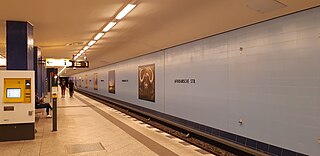
Afrikanische Straße is a station in the Wedding district of Berlin which serves the line and is operated by the BVG. The station is located under the Müllerstraße, one of the district's major shopping streets and thoroughfares, but named for another major street nearby. The BVG uses the station under the internal abbreviation Afr; the train station is 631 meters from the Kurt-Schumacher-Platz U-Bahn Station and 587 meters from the Rehberge U-Bahn Station.

Rehberge is a station in the Wedding district of Berlin which serves the line and is operated by the BVG. The station is named for Volkspark Rehberge, the large public park approximately 500m away, a name which literally translates as '(Roe) Deer Mountains'. The station was opened on 3 May 1956, along with the rest of the route between Seestraße and Kurt-Schumacher-Platz.

Platz der Luftbrücke is a Berlin U-Bahn station located on the . It is located under Platz der Luftbrücke and the south end of Mehringdamm on the border between Kreuzberg and Tempelhof, near the former Tempelhof International Airport, and is now named for the square there with its memorial to the victims of the Berlin Airlift.

Walther-Schreiber-Platz is a Berlin U-Bahn station located on the line in Steglitz-Zehlendorf. Built from 1967 to 1969, the station is located completely under the Bundesallee, which flows into Walther-Schreiber-Platz. The station was opened on 29 January 1971, and until September 1974 was the southern terminus of the former Line 9.

Berlin Potsdamer Platz is a railway station in Berlin. It is completely underground and situated under Potsdamer Platz in central Berlin. Regional and S-Bahn services call at the station, and it is also served by U-Bahn line U2.

Berlin Humboldthain is a railway station in the city of Berlin, Germany. It is served by the Berlin S-Bahn lines ,, and . It is also served by local bus route 247.
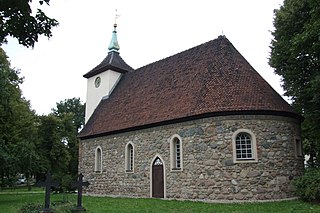
Reinickendorf is a locality of Berlin in the borough of Reinickendorf. It had a population of 83,972 in 2020.

Berlin Tegel is a railway station in Tegel, a locality of the Reinickendorf borough of Berlin. It is served by the S-Bahn line .

Hennigsdorf is a railway station in the Oberhavel district of Brandenburg, located in the town of Hennigsdorf. It is the northern terminus of the S-Bahn line as well as a station for regional passenger trains and freight services.

Bus transport is the oldest public transport service in Berlin, the capital city of Germany, having been introduced in 1846. Since 1929, services have been operated by the Berlin Transport Company, although during the Cold War-era division of the city they operated in West Berlin only. BVG's fleet consists of 1,300 vehicles, which cover 300,000 kilometres per day.

![]() line of the Berlin U-Bahn. There had been a bus link outside the station connecting Berlin's Tegel International Airport to the U-Bahn network. The station was opened on 3 May 1956 and named after famous German politician Kurt Schumacher.
line of the Berlin U-Bahn. There had been a bus link outside the station connecting Berlin's Tegel International Airport to the U-Bahn network. The station was opened on 3 May 1956 and named after famous German politician Kurt Schumacher.

















